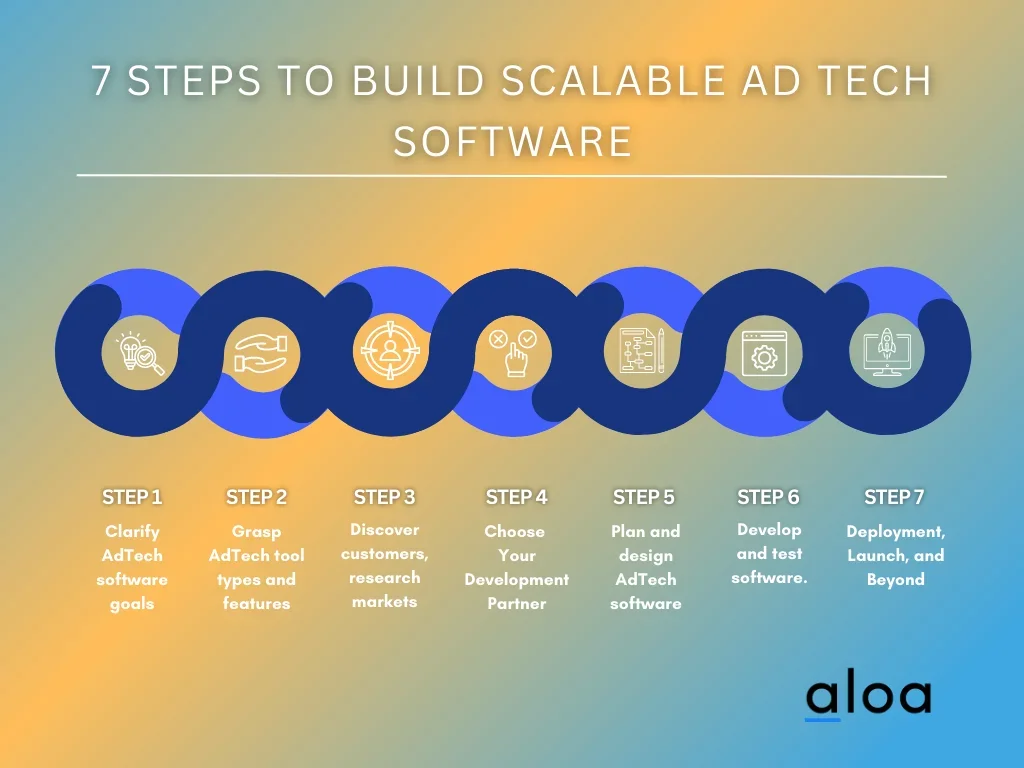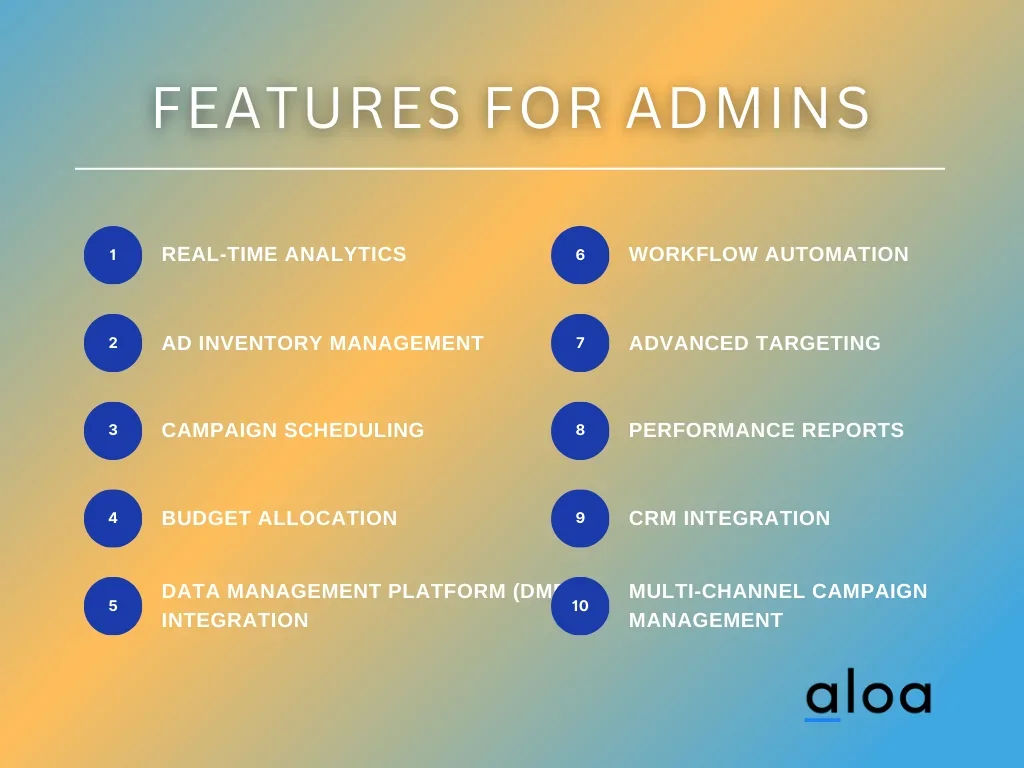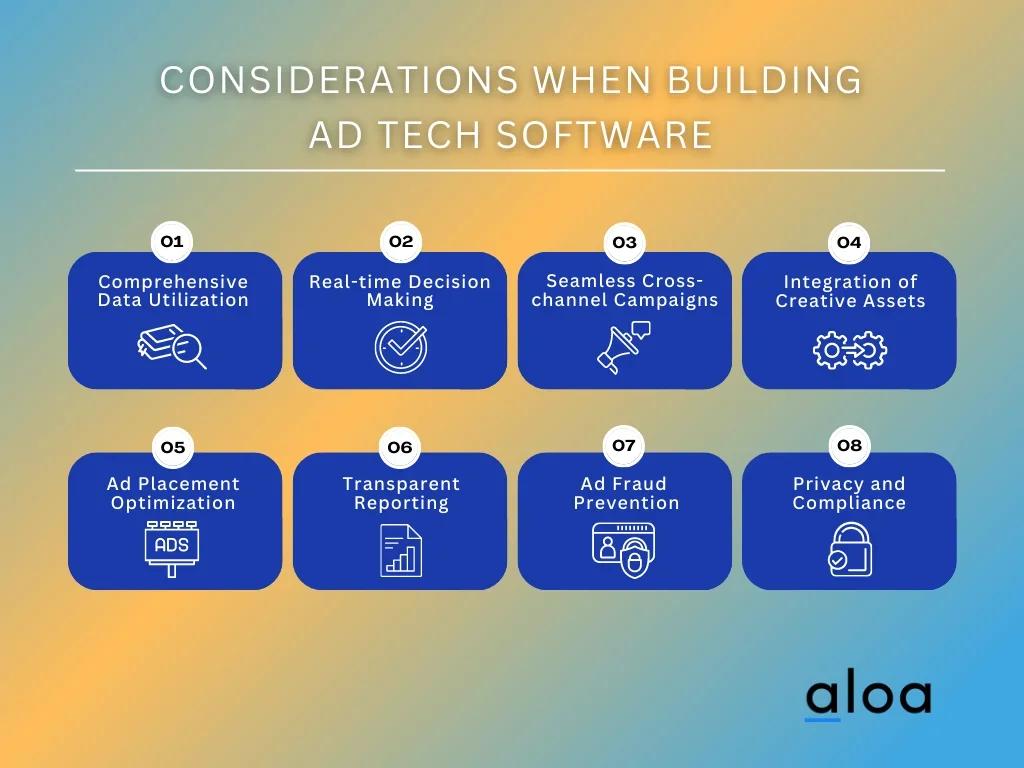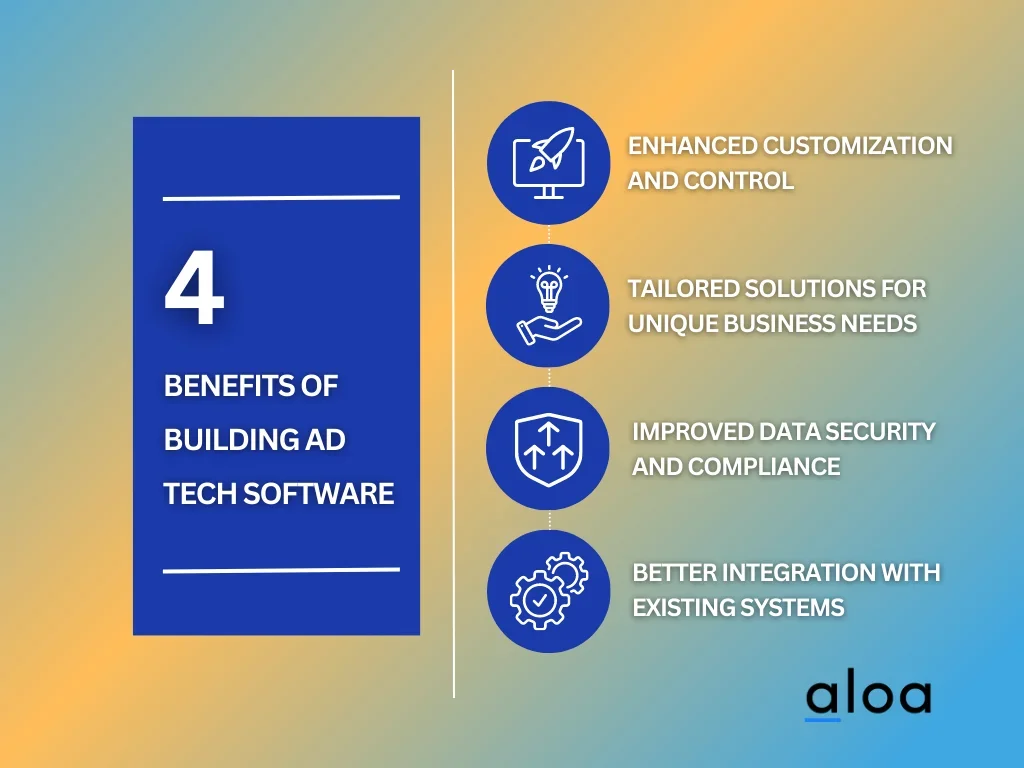Digital advertising relies heavily on ad tech software, which plays a vital role in enabling marketers to navigate the complexities of the advertising technology landscape. This software empowers them to efficiently and precisely manage their ad campaigns. However, creating scalable ad tech software presents a unique challenge that necessitates a deep understanding of adtech, automation, and optimization.
Aloa, a leading expert in software outsourcing, is vital in supporting startups and businesses venturing into ad tech software development. By providing invaluable guidance throughout the complexities and challenges that arise, Aloa enables businesses to leverage the potential of adtech and devise solutions that effectively respond to the requirements of contemporary advertising.
This comprehensive guide will walk you through developing scalable advertising technology software. The objective is to provide you with the necessary knowledge and insights to create impactful ad tech solutions that effectively reach your target audience.
In the highly competitive digital advertising market, one must thoroughly understand the process, obstacles, and advantages of developing standout ad tech software. This exploration will delve into the construction of advertising technology software that yields remarkable outcomes within the ever-evolving landscape of digital advertising.
Let's dive in!
7 Steps to Build Scalable Ad Tech Software
In today's rapidly changing digital advertising landscape, it has become crucial for companies to develop scalable ad tech software to establish themselves as industry leaders. Let's explore a comprehensive roadmap for building advertising technology software providing valuable insights on navigating each step of creating impactful ad tech solutions.

Step 1: Define Your Ad Tech Software Goals
To create a successful ad tech software, it is essential to have a clear understanding of its goals. Start by identifying the specific objectives you want to achieve with your software and the outcomes you aim to deliver. Additionally, define the challenges within the ad tech industry your software intends to address. This step thoroughly assesses the pain points experienced by businesses, advertisers, and marketers alike.
It's essential to clearly define the target audience and industries that your advertising technology software will serve. Whether it's for programmatic advertising, data analytics, or ad fraud prevention, having a clear goal will guide the development process.
Step 2: Understand Ad Tech Tool Types and Features
The ad tech field encompasses a broad range of tools that cater to different needs within the industry. These tools include neration, programmatic advertising, data analytics, and ad fraud prevention. It is important to explore each type and understand the core features required from both user and administrative perspectives to ensure that your software provides a seamless and comprehensive experience.
Step 3: Customer Discovery and Market Research
To create advertising technology software that truly resonates with your target audience, thorough market research is necessary. Engage with potential users, gather insights, and attentively listen to their concerns—this phase of customer discovery aids in identifying gaps in the market and opportunities for innovation. One effective method for gathering this feedback is to generate a QR code that leads them to a survey form. Utilize the feedback you collect to develop detailed user personas that embody your prospective users' characteristics, behaviors, and preferences. These personas will serve as a guiding framework throughout the software development process, ensuring alignment with the needs of your audience.
Step 4: Choose Your Development Partner
Choosing the right development partner is a crucial decision that can determine the success or failure of your ad tech software project. When evaluating potential partners, consider their expertise, experience, and alignment with your vision. Look for partners with a proven track record in developing adtech software and possess the technical skills necessary to bring your ideas to fruition.
If you're at a stage where you're considering partnership, Aloa is a trusted team of software development experts with a specialization in the ad tech industry. Their extensive experience and dedication to delivering high-quality results make them a reliable choice for bringing your vision to life.
Step 5: Plan and Design Your Ad Tech Software
To create effective advertising technology software, it's crucial to have a well-structured plan and thoughtful design. Start by developing a comprehensive plan that outlines the desired features, functionalities, and user interfaces of the software. Then, visualize the user experience by creating wireframes and prototypes. These tools allow for early feedback, helping to refine the design before development begins
Step 6: Software Development and Testing
Partner closely with your chosen development team to kickstart the software-building process. As you dive into development, focus on implementing user-friendly features for users and administrators while keeping the interface intuitive. However, remember that the development phase isn't solely about creation; rigorous testing is paramount. By performing comprehensive testing, you can identify and resolve bugs, glitches, and performance issues to ensure a stable and seamless software experience for your users.
Step 7: Deployment, Launch, and Beyond
After selecting a fitting hosting solution that meets the specific requirements of your software, proceed to establish the necessary infrastructure for deployment. Once accomplished, launch your advertising technology software, ensuring accessibility to your intended audience. However, remember that this is just the beginning of the journey. It is imperative to maintain continuous monitoring of performance, gather user feedback, and implement updates and improvements consistently to guarantee long-term success for your software.
Standard Features in Ad Tech Software
Advertising technology software plays a crucial role in the dynamic realm of online advertising by empowering businesses to execute successful marketing campaigns. Adtech encompasses various tools and platforms that are designed explicitly for optimizing and streamlining advertisements. Now, let's explore the essential features of advertising technology software catering to administrators and users.
Features for Admins
Administrators are the backbone of any ad tech ecosystem. They require comprehensive control and insights to make informed decisions. Advertising technology software offers a range of features that empower administrators to efficiently manage campaigns, analyze performance, and make data-driven adjustments.

- Real-time Analytics: Adtech software provides administrators with real-time insights into campaign performance, empowering them to make strategic decisions based on up-to-the-minute data. This ensures that administrators have complete visibility and can effectively optimize
- Ad Inventory Management: Efficiently manage ad space and placement, optimizing ad inventory to ensure maximum exposure while adhering to the budget.
- Campaign Scheduling: Administrators can schedule campaigns to go live at specific times, ensuring ads reach the right audience at the right moment.
- Budget Allocation: Advertising technology software empowers administrators to effectively allocate budgets across campaigns, channels, and platforms, ensuring optimal utilization of resources.
- Data Management Platform (DMP) Integration: Integrate customer data from various sources, enabling precise targeting and advertisement personalization.
- Workflow Automation: Campaign creation and management can be streamlined through workflow automation, which effectively reduces the need for manual tasks and eliminates potential errors. Such automation enhances efficiency.
- Advanced Targeting: Utilize artificial intelligence and machine learning to identify the right people for a particular ad, enhancing audience targeting accuracy.
- Performance Reports: Detailed reports are generated to analyze campaign performance, measuring key metrics and providing valuable insights for refining strategies.
- CRM Integration: Integrate with customer relationship management systems to enhance understanding customer behavior and preferences.
- Multi-Channel Campaign Management: Admins can manage campaigns across various channels, from social media to email and display ads, all within a single interface.
Features for Users
Advertising technology software isn't just about administrators; it also benefits users who engage with ads. These features enhance user experience, ensuring the right content reaches the right audience, fostering engagement, and driving conversions.
.webp)
- Personalization: Adtech software leverages user data to deliver personalized advertisements that resonate with individual preferences and behaviors.
- Contextual Targeting: Ads are displayed based on the content users engage with, enhancing relevance and user engagement.
- Interactive Ad Formats: Users can interact with ads, such as surveys or quizzes, creating a more engaging and immersive experience.
- Mobile Optimization: Adtech software ensures ads are optimized for mobile devices, providing a seamless experience across different screen sizes.
- Video Ads: Video content is a powerful tool, and adtech software delivers captivating video ads to users across platforms.
- Social Media Integration: Reach users on platforms like Facebook, Instagram, and YouTube, where they spend a significant amount of time.
- Dynamic Ads: Display ads dynamically change based on user behavior and preferences, increasing the likelihood of conversions.
- Real-time Bidding: Users are exposed to advertisements won in real-time auctions, ensuring relevancy and value for advertisers.
- Ad Blocking Prevention: Some adtech software helps prevent ad-blockers from interfering with ad delivery, ensuring that the intended audience sees the ads.
- Frequency Capping: Users are not repeatedly bombarded with the same ad, creating a more positive user experience.
Considerations When Building Ad Tech Software
The way advertising campaigns are conceptualized, executed, and optimized has been entirely transformed by adtech. To stay ahead in this dynamic field, marketers and adtech companies must deeply understand the intricacies of building adtech software. Here are some essential considerations for them to keep in mind.

Comprehensive Data Utilization
Adtech software relies heavily on data. The collection, processing, and analysis of data from various sources are crucial for making well-informed decisions. It is imperative that the software seamlessly integrates these data streams coming from customer data platforms (CDPs) that consolidate customer information and first-party data gathered directly from users.
Real-time Decision Making
In the world of programmatic advertising, quick decision-making is crucial. Demand-side platforms (DSPs) swiftly place real-time ad bids using available data. Adtech software optimizes bidding strategies by considering user behavior, keywords, and estimated ad space costs. This ensures that ads are strategically placed for maximum impact.
Seamless Cross-channel Campaigns
In today's advertising landscape, campaigns have expanded their reach across various platforms. This includes popular social media channels like Facebook ads and more traditional outlets such as TV and online media. To keep up with this multi-channel approach, adtech software plays a crucial role in facilitating the creation and management of cross-channel campaigns. It ensures that messaging and creative assets
Integration of Creative Assets
Compelling creatives lie at the core of successful advertising. The software should facilitate seamless integration of diverse ad formats, including videos, banners, and interactive ads. This empowers marketers to deliver captivating content tailored to each platform's specific requirements.
Ad Placement Optimization
Determining the optimal placement of advertisements holds great significance. The software utilizes supply-side platforms (SSPs) and ad exchange to pinpoint the most favorable ad inventory and placement opportunities to achieve this. Doing so effectively boosts visibility and engagement while conserving resources by avoiding irrelevant placements.
Transparent Reporting
Marketers must possess a thorough understanding of their campaign's effectiveness. They require software that provides comprehensive reporting and analytics, offering insights into crucial performance indicators (KPIs) such as click-through rates, conversion rates, and return on investment (ROI). Transparent reporting allows marketers to make data-driven adjustments to their strategies.
Ad Fraud Prevention
Ad fraud remains a significant concern within the realm of digital advertising. To combat this issue, efficient advertising technology software must integrate advanced fraud detection mechanisms. These features serve the purpose of identifying and mitigating fraudulent activities, thereby ensuring that marketing budgets are allocated exclusively towards authentic interactions.
Privacy and Compliance
The software must prioritize protecting user data in alignment with evolving data privacy regulations like GDPR and CCPA. It should offer robust features for efficiently managing user consent, secure data storage, and ensuring compliance with applicable regulations.
Benefits of Building Ad Tech Software
In the rapidly changing world of digital advertising, creating advanced adtech software provides numerous advantages. By actively participating in this development process, companies can harness a range of benefits that are essential for their growth and success.

Enhanced Customization and Control
By developing their advertising technology software, businesses can shape the solution to fit their specific needs. This high level of customization enables companies to align the functionality of the software with their unique business strategies and goals. Unlike pre-made solutions, custom adtech software allows for fine-tuning every aspect, ensuring a seamless fit and optimizing overall performance.
Tailored Solutions for Unique Business Needs
In digital advertising, a one-size-fits-all approach just doesn't cut it. By developing advertising technology software customized to meet specific business needs, organizations gain a competitive edge. This tailored approach allows them to tackle industry-specific challenges, leverage niche opportunities, and optimize their operational model. The result? More impactful marketing campaigns, data-driven insights, and a higher return on investment (ROI).
Improved Data Security and Compliance
In today's age of frequent data breaches and growing privacy concerns, developing in-house ad tech software provides a valuable safeguard for enhanced data security. Companies can establish strong protective measures to safeguard sensitive user and business information. Moreover, maintaining complete control over the software allows organizations to implement compliance protocols aligned with industry-specific regulations, fostering trust among users and stakeholders.
Better Integration with Existing Systems
In a competitive market, efficiency and synergy are crucial. By developing personalized adtech software, companies can achieve seamless integration with their current systems and tools. This integration promotes collaboration, streamlines processes, and provides a comprehensive view of the marketing ecosystem. Instead of dealing with fragmented solutions, businesses can unify their operations, allowing data to flow effortlessly and driving increased productivity.
Key Takeaway
Creating powerful ad tech software requires understanding the different types of tools and their core features. By comprehending the distinct requirements of programmatic advertising platforms, data analytics and insights software, as well as ad fraud detection and prevention solutions, businesses can effectively customize their offerings. This strategic approach offers significant advantages to both startups and established enterprises, ensuring tailored solutions that meet specific business needs.
Reach out to our team at re[email protected] for comprehensive insights and guidance. Our experienced professionals are ready to assist you in navigating the ever-evolving landscape of ad tech, empowering you with cutting-edge technologies and strategies that unlock its full potential. Elevate your business's reach and impact in the ever-evolving digital advertising landscape with well-crafted ad tech software that resonates with your target audience and meets their distinct demands.

